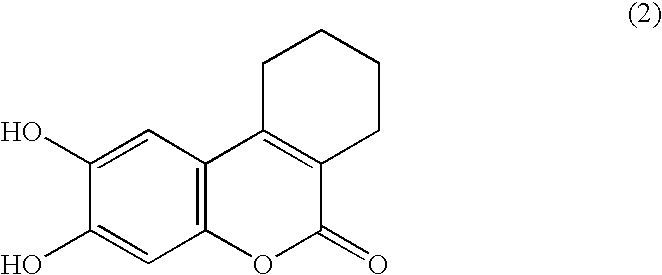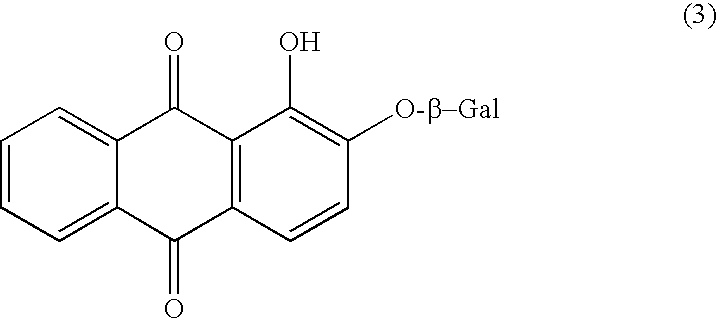Chromogenic enzyme substrates and kits containing them
a technology of enzyme substrates and kits, applied in the field of enzyme substrates, can solve the problems of ph dependant intensity of fluorescence, difficult to pick out positive colonies from within a mixed culture, and substrates also have disadvantages including spreading
- Summary
- Abstract
- Description
- Claims
- Application Information
AI Technical Summary
Benefits of technology
Problems solved by technology
Method used
Image
Examples
example 2
Synthesis and Evaluation of 3',4'-dihydroxyflavone-4'-.beta.-D-ribofuranos-ide Sodium Salt (DHF-riboside)
[0092] A 50 ml round bottomed flask equipped with a stopper and a magnetic stirrer was charged with 3',4'-dihydroxyflavone (Lancaster Synthesis Ltd, Lancashire, UK) (500 mg), .beta.-D-ribofuranose tetraacetate (640 mg), 3 .ANG. molecular sieves (5.2 g) and dichloromethane (20 ml). The mixture was stirred for 15 minutes, then the boron trifluoride diethyl etherate catalyst (20 ml) was added in one portion. Stirring was continued for a further 20 minutes, then the reaction mixture was poured into a solution of saturated sodium bicarbonate (150 ml). The organic layer was diluted by the addition of more dichloromethane (30 ml) and then separated from the yellow aqueous layer in a separating funnel. The organic layer was then washed eleven times with an equal volume of saturated sodium bicarbonate solution then dried for one hour over magnesium sulfate. After removal of the drying age...
example 3
3',4'-Dihydroxyflavone-4'-.beta.-galactopyranoside sodium salt
[0100] Sodium hydroxide (0.08 g) was dissolved in deionised water (2.33 g) and the resulting solution was cooled to 4.degree. C. in a refrigerator. Meanwhile, 3',4'-dihydroxyflavone (0.5 g), acetobromogalactose (0.918 g) and acetone (5.57 ml) were added to a 25 ml round bottomed flask equipped with a magnetic stirrer and stirred for 5 mins. The cooled sodium hydroxide solution was added to the suspension of 3,'4'-dihydroxyflavone and the mixture changed from a yellow / brown suspension into a deep-red / brown solution. After stirring at room temperature for 5-10 mins., the reaction mixture had become an orange / brown suspension. Stirring was continued overnight at ambient temperature. The precipitated 3',4'-dihydroxyflavone was filtered off, washing through with acetone (5-10 ml) and the filtrate was evaporated down using a rotary evaporator to form two distinct phases. The top layer (aqueous) was discarded and the lower layer...
example 4
3',4'-Dihdroxyflavone-4'-phosphate
[0101] 3',4'-Dihydroxyflavone (127 mg) was suspended in acetonitrile (15 ml) in a 50 ml round bottomed flask with nitrogen inlet and side arm. After flushing with nitrogen for 10 mins the suspension was cooled to -10.degree. C. and carbon tetrachloride (0.26 ml), diisopropylethylamine (0.2 ml) and dimethylaminopyridine (6 mg) were added via the side arm. After stirring for 1 min, dibenzylphosphite (290 mg) was added dropwise. After 1 h, a mixture composed of a solution of potassium dihydrogen phosphate (0.5 moles) in water (3 ml) and acetonitrile (20 ml) was added and the solution extracted with ethyl acetate (3.times.25 ml). After drying over magnesium sulphate the solution was filtered and the filtrate concentrated in vacuo. The orange oil so obtained was dissolved in methanol (15 ml) and 10% palladium on charcoal catalyst (25 mg) was added. After flushing with nitrogen the benzyl groups were removed by passing hydrogen through the solution for 1 ...
PUM
| Property | Measurement | Unit |
|---|---|---|
| Aromaticity | aaaaa | aaaaa |
| Enzyme activity | aaaaa | aaaaa |
Abstract
Description
Claims
Application Information
 Login to View More
Login to View More - R&D
- Intellectual Property
- Life Sciences
- Materials
- Tech Scout
- Unparalleled Data Quality
- Higher Quality Content
- 60% Fewer Hallucinations
Browse by: Latest US Patents, China's latest patents, Technical Efficacy Thesaurus, Application Domain, Technology Topic, Popular Technical Reports.
© 2025 PatSnap. All rights reserved.Legal|Privacy policy|Modern Slavery Act Transparency Statement|Sitemap|About US| Contact US: help@patsnap.com



